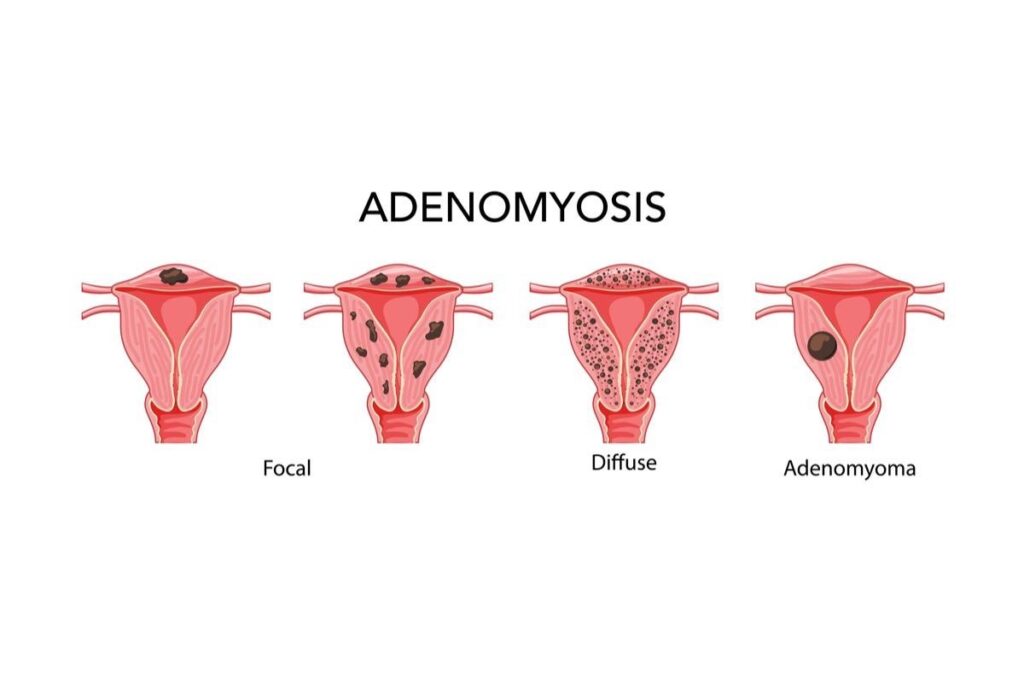
- A condition where the endometrial tissue (uterine lining) grows into the muscular wall of the uterus, causing pain and heavy bleeding.
Adenomyosis is a gynecological condition in which the inner lining of the uterus (endometrium) breaks through the muscular wall of the uterus (called the myometrium). This condition can lead to an enlarged uterus, painful periods, and heavy menstrual bleeding. It is often confused with endometriosis, but they are different conditions.
🧬 What Is Adenomyosis?
- Normally, the endometrial tissue lines only the inner cavity of the uterus.
- In adenomyosis, this tissue invades the uterine muscle wall.
- During the menstrual cycle, this misplaced tissue behaves like normal endometrial tissue — it thickens, breaks down, and bleeds. But since it’s trapped in the muscle, it causes:
- Swelling
- Pain
- Inflammation
📊 Who Is Affected?
- Typically affects women in their 30s to 50s
- More common in women who:
- Have had children (multiparous)
- Have undergone uterine surgery (like C-sections or fibroid removal)
- Are approaching menopause
📍 Symptoms of Adenomyosis
Not all women have symptoms, but when they do, they may experience:
- Heavy or prolonged menstrual bleeding (menorrhagia)
- Severe menstrual cramps (dysmenorrhea)
- Chronic pelvic pain
- Painful intercourse (dyspareunia)
- Enlarged, tender uterus (can feel like a bloated or heavy lower abdomen)
- Spotting or bleeding between periods
🧪 Causes and Risk Factors
The exact cause is unknown, but theories include:
- Invasive tissue growth: Endometrial cells invade the uterine muscle.
- Uterine inflammation: Related to childbirth or surgery.
- Developmental origins: Abnormal development of endometrial tissue in the uterus before birth.
Risk Factors:
- Age (30–50)
- Previous uterine surgeries (C-section, D&C, fibroid removal)
- Childbirth history
- High estrogen levels
🔬 Diagnosis of Adenomyosis
Adenomyosis is hard to diagnose without surgery, but modern imaging helps:
- Pelvic exam: Enlarged, tender uterus
- Ultrasound: Can reveal thickened myometrium or cystic areas
- MRI: More accurate in identifying adenomyosis
- Histopathology (definitive): Requires tissue examination after hysterectomy
Note: Often diagnosed by ruling out other causes like fibroids or endometriosis.
💊 Treatment Options
🟢 Non-Surgical Treatments
- NSAIDs: For pain relief
- Hormonal therapy:
- Birth control pills
- IUDs with progestin (like Mirena)
- GnRH agonists to reduce estrogen
🟠 Minimally Invasive/Surgical Options
- Uterine artery embolization (UAE): Cuts off blood supply to affected area
- Endometrial ablation: Destroys uterine lining (not effective for deep adenomyosis)
- Hysterectomy: Complete removal of the uterus (curative for adenomyosis)
🧘♀️ Living with Adenomyosis
- Lifestyle support:
- Heat pads, yoga, relaxation techniques
- Anti-inflammatory diets
- Emotional impact: Can affect quality of life, so counseling/support groups may help
- Fertility: Unlike endometriosis, adenomyosis can affect fertility, though many women still conceive successfully
🔄 Adenomyosis vs. Endometriosis
| Feature | Adenomyosis | Endometriosis |
|---|---|---|
| Affected Area | Uterine muscle (myometrium) | Outside uterus (e.g., ovaries) |
| Symptoms | Heavy bleeding, painful periods | Pain, infertility, pelvic pain |
| Diagnosis | Imaging or after hysterectomy | Laparoscopy |
| Treatment | Hormonal/surgical | Hormonal/surgical |
| Curable? | Hysterectomy is curative | No absolute cure |
Let me know if you’d like a visual diagram, infographic, or want to explore natural remedies, fertility concerns, or diet tips for adenomyosis.

